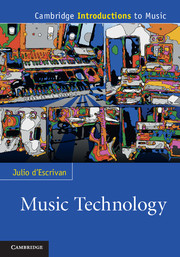Book contents
- Frontmatter
- Contents
- Preface
- Acknowledgements
- Figures
- Chapter 1 Representing and storing sound
- Chapter 2 A studio overview
- Chapter 3 Synthesisers, samplers and drum machines
- Chapter 4 Live music technology (the FAQs)
- Chapter 5 Select, remix, mashup
- Chapter 6 The producer
- Chapter 7 Music, sound and visual media
- Chapter 8 The studio as experimental lab
- Chapter 9 Controllers: new creative possibilities in performance
- Chapter 10 Hacking electronics for music
- Further avenues for exploration
- Notes
- Glossary
- Bibliography
- Index
Preface
Published online by Cambridge University Press: 05 June 2012
- Frontmatter
- Contents
- Preface
- Acknowledgements
- Figures
- Chapter 1 Representing and storing sound
- Chapter 2 A studio overview
- Chapter 3 Synthesisers, samplers and drum machines
- Chapter 4 Live music technology (the FAQs)
- Chapter 5 Select, remix, mashup
- Chapter 6 The producer
- Chapter 7 Music, sound and visual media
- Chapter 8 The studio as experimental lab
- Chapter 9 Controllers: new creative possibilities in performance
- Chapter 10 Hacking electronics for music
- Further avenues for exploration
- Notes
- Glossary
- Bibliography
- Index
Summary
It is difficult to know exactly when electronic music became part of university curricula, but it was probably as early as the 1960s, at least at graduate level. However, we can safely say that ‘music technology’ as a subject, or as the title of a course, is a fairly recent development. The term probably began to be used in the late 1990s and has only become a standard feature of the higher education on offer in the 2000s. There are a great number of music technology courses all over the world. In Great Britain alone there are, at the time of writing, around eighty-three higher education institutions that offer BA Honours degrees in some aspect of music technology: creative music technology, sound technology, music production, music and sonic arts, and many other variations. The subject is popular and encompasses a wide variety of topics, including sound synthesis, composition, sonic art, electronic music, music for media, computer music and many others.
The problem is, in a sense, how wide ranging the choices are. It is a problem for students, since under a similar heading they can expect very different courses from different institutions. It is a problem for universities, because there are many types of candidates with different but useful skill-sets that are suitable for the course (two of my best students did not have any music background, but had foundation studies in art and design).
- Type
- Chapter
- Information
- Music Technology , pp. xiii - xivPublisher: Cambridge University PressPrint publication year: 2011

